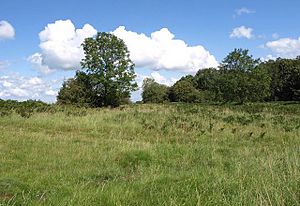Burrington Camp facts for kids
Quick facts for kids Burrington Camp |
|
|---|---|
| Native name Burrington Ham | |
 |
|
| Location | Burrington, Somerset, England |
| Built | Iron Age |
| Reference no. | 194391 |
| Lua error in Module:Location_map at line 420: attempt to index field 'wikibase' (a nil value). | |
Burrington Camp, also known as Burrington Ham, is an ancient hill fort from the Iron Age. You can find it in the Mendip Hills in Somerset, England. It's about 1 kilometer (0.6 miles) south of the village of Burrington.
This old camp sits high up, looking over a valley called Burrington Combe. People have found many old things here, like ancient burial sites. This shows that people have lived in this area for a very, very long time. Burrington Camp is shaped like an oval. It is a univallate hill fort, which means it has one main defensive wall or ditch.
Before the 1900s, this place was often called "Burrington Ham." Some people even thought it was a Roman camp back then. Others believed it was connected to the Druids, who were ancient Celtic priests.
What is a Hill Fort?
Hill forts are large, fortified settlements built on hills. They were common during the Late Bronze Age and Early Iron Age. This was roughly around 1000 BC. People built them for different reasons.
Why Were Hill Forts Built?
Experts have debated why these forts appeared in Britain. Some think they were military sites, built to defend against invaders. Others believe they were built by invaders themselves. Another idea is that they were a response to social problems. As more people lived in an area, there was more pressure on farming. This could lead to conflicts.
Many experts now believe that the discovery of iron changed society. Iron ore was found in different places than the tin and copper used for bronze. This changed how people traded goods. Old leaders might have lost their power. New groups of people gained importance.
Archaeologist Barry Cunliffe suggests that more people living in an area played a role. He thinks hill forts offered protection when tensions led to fighting. He doesn't believe they were built only because there was a constant war. They were useful strongholds during times of trouble. Some were even attacked and destroyed. But defense was just one reason for their creation.

